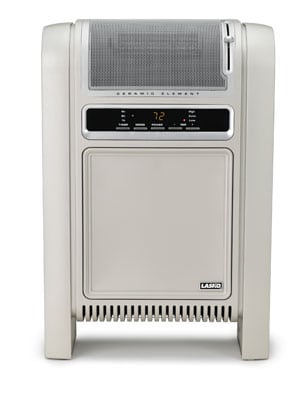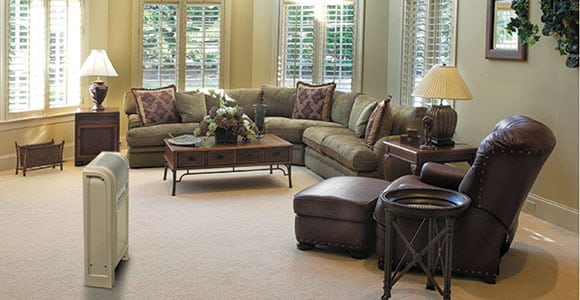Dear Jim: I’m considering a small electric space heater for my living room and bedroom. What space heaters are best for these spaces, and will they cut my utility bills as some ads claim? — Greg R.
Dear Greg: Small electric space heaters can reduce your utility bills but only if you set your central heating system (heat pump or furnace) thermostat lower. They make sense if there are only one or two people living in a house with no need to keep vacant rooms warm.
 Another common situation is when there is a room or two in a house that do not stay warm enough. Often a person gets chilly in one of those rooms and turns the central thermostat higher. This warms the entire house, and more heat is lost through the walls, windows and ceiling. It is much more efficient to use a small space heater in these problem rooms.
Another common situation is when there is a room or two in a house that do not stay warm enough. Often a person gets chilly in one of those rooms and turns the central thermostat higher. This warms the entire house, and more heat is lost through the walls, windows and ceiling. It is much more efficient to use a small space heater in these problem rooms.
First, it is important to understand that all electric space heaters are effectively 100-percent efficient. Don’t let advertising stating this fact influence your buying decision. This just means all of the electricity it consumes ends up as heat in your house. It does not mean it’s cheap to operate.
Also, the maximum heat most small space heaters can safely produce is about 5,100 Btuh (Btu per hour). Houses typically use central heating systems with a capacity of 50,000 to 100,000 Btuh, so a single space heater cannot heat an entire house. Be wary of advertising stating a small electric space heater can allow your central system to run dramatically less for 50 percent or more savings.
There’s not a “best” electric space heater for every situation. The proper selection depends on the room and how you plan to use the heater. For example, are you looking for quiet heat in a bedroom at night, heat for just one person watching TV or a way to warm a group of people in a large room?
Choose between direct radiant and convection (air circulation) space heaters; both types have advantages. Within each group, there are many comfort features and options that may impact your decision. If you have young children, there are also safety considerations.
Radiant space heaters
Radiant-style heaters heat quickly. These use a red-hot ribbon, long quartz or carbon tubes to produce infrared heat radiation similar to the sun’s rays. They primarily heat objects and people directly in front of them. Carbon tubes produce infrared heat that penetrates objects and skin slightly below the surface. This makes it very comfortable, effective heat.
Radiant heaters are quiet and ideal for heating a specific spot. For example, I use one across from my computer desk to keep me warm while I am writing. My body and the furniture in its path gradually reradiate the heat so the room air also heats up slightly. To heat a slightly larger area, select a model that automatically oscillates.
Convection space heaters
Convection heaters are designed to heat the air in the room. This is often done using a built-in fan to circulate room air over the heating elements. Oil-filled, old radiator-style heaters use natural air circulation (hot air rises) to move room air over the heat source, gently warming a room without bursts of heat.
For a living room, often the largest room in a house, consider a convection-style heater. This heats an entire room more effectively. Choose a model with a thermostat and multispeed fan to control the heat output. A ceramic convection heater is safe around young children. If the airflow gest blocked, the heating output automatically drops, and there are no red-hot ribbons.
For a bedroom, where quiet operation is important, use an oil-filled radiator or a convection heater with a low-speed setting. Another option is a radiant model facing the bed if you don’t mind the red glow. A horizontal-shaped one will heat the entire bed area.
The following companies offer electric space heaters: Delonghi, 866-528-8323, www.delonghi.com; Holmes Products, 800-546-5637 www.holmesproducts.com, KAZ/Honeywell, 800-477-0457, www.kaz.com; Lasko, www.laskoproducts.com, 800-233-0268; Slant Fin 516-484-2600, www.slantfin.com.
Have a question for Jim?
Send inquiries to James Dulley, The Tennessee Magazine, 6906 Royalgreen Drive, Cincinnati, OH 45244, or visit www.dulley.com.



